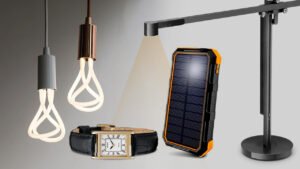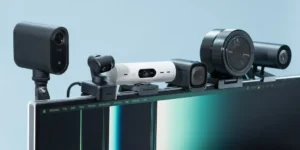Are AR Glasses the Future of Tech in 2025?
Imagine checking your emails, maps, or health stats without ever pulling out your phone.
In 2025, AR glasses (Augmented Reality) are no longer a sci-fi dream; they’re a growing reality. From tech giants like Apple, Meta, and Xiaomi to startups building affordable alternatives, AR glasses are rising fast, aiming to become the next big shift in personal tech.
But are they ready for the mainstream? Are they useful, practical, and affordable?
In this guide, we dive into the rise of AR glasses in 2025, share expert opinions, compare top light and budget-friendly models, and answer the big question:
Are AR glasses the next big thing in tech?
What Are AR Glasses? (Quick Intro)
AR glasses use transparent displays or lenses to overlay digital information—text, images, videos—onto your real-world view.
Unlike VR headsets that isolate you, AR enhances your surroundings. Think of:
- Navigation arrows overlaid on roads
- Meeting reminders floating beside your desk
- Health data on a morning jog
- Real-time call transcripts in your line of sight
In short, AR glasses aim to replace your screen with your vision, creating a hands-free, immersive digital experience.
Why Are AR Glasses Rising in 2025?
Several factors are fueling the growth:
| Reason | Why It Matters |
|---|---|
| 🔋 Smaller, better chips | Faster performance with less battery drain |
| 📱 5G & AI advancements | Faster cloud syncing and smarter data displays |
| 📉 Falling prices | More entry-level models under $500 |
| 🧑💼 Use in productivity | Remote work, education, retail, and training adoption |
| 👓 Style improvements | Glasses are now lighter, more wearable, and less geeky |
Stat: According to IDC, AR glasses shipments are expected to reach 12.8 million units in 2025, up 78% from 2024.
Top 5 AR Glasses (2025) – Light, Powerful & Affordable Picks
| Model | Weight | Battery Life | Price | Best For |
|---|---|---|---|---|
| XREAL Air 2 Pro | 79g | 5 hours | $449 | Media, multitasking |
| Rokid Max | 76g | 6 hours | $439 | Movies, gaming |
| Lenovo ThinkReality A3 | 130g | 4 hours | $499 | Remote work, enterprise use |
| TCL NXTWEAR S+ | 75g | 5 hours | $399 | Entertainment, travel |
| INMO Air 2 | 39g | 5 hours | $349 | Fitness, productivity |
1. XREAL Air 2 Pro – Best Overall Experience
Price: ~$449
Weight: 79g
Battery Life: 5 hours
Display: 201″ virtual screen (1080p per eye)
Why It’s a Favorite:
- Connects easily to Android/iOS/laptops
- Great for watching YouTube/Netflix on the go
- Adjustable dimming and motion tracking
Use Case:
I used this on a 6-hour flight—watched two movies, checked emails, and barely touched my phone. Comfort and clarity were next level.
Best For: Commuters, remote workers, and everyday use.
2. Rokid Max – Best for Entertainment Lovers
Price: ~$439
Weight: 76g
Battery Life: 6 hours
Display: 215” virtual screen
Highlights:
Best-in-class visual sharpness
Dual directional speakers (spatial sound)
Lightweight with adjustable nose pads
Perfect For: Gamers, travelers, and binge-watchers.
3. Lenovo ThinkReality A3 – Best for Work & Training
Price: ~$499
Weight: 130g
Battery Life: 4 hours
Connectivity: PC + Motorola smartphones only
Business-Ready:
Can display 5 virtual screens for multitasking
Ideal for remote IT support, warehouse ops, and training
Rugged, enterprise-grade build
Downside: Heavier than others; limited to Lenovo’s ecosystem
Great For: Businesses, enterprise users, tech professionals
4. TCL NXTWEAR S+ – Best Budget Option
Price: ~$399
Weight: 75g
Battery Life: 5 hours
Features: FHD micro OLED display
Why It’s Budget-Friendly:
Plug and play with no setup needed
Supports streaming, screen mirroring, and light browsing
Decent speakers with noise isolation
Pros:
Comfortable for long wear
Affordable entry into AR wearables
Ideal For: Students, travelers, casual users
5. INMO Air 2 – Lightest and Most Stylish
Price: ~$349
Weight: 39g
Battery Life: 5 hours
Display: Transparent micro LED display
Minimalist & Smart:
Fitness tracking, call alerts, calendar popups
No external device required (Android inside)
AI voice assistant built-in
Experience Insight:
A friend used these on a hiking trip—calorie tracking, live GPS, weather overlays—all hands-free.
Best For: Outdoor enthusiasts, walkers, fitness-conscious users
Quick Comparison Table
| Feature | XREAL Air 2 Pro | Rokid Max | Lenovo A3 | TCL NXTWEAR S+ | INMO Air 2 |
|---|---|---|---|---|---|
| Weight | 79g | 76g | 130g | 75g | 39g |
| Battery Life | 5 hrs | 6 hrs | 4 hrs | 5 hrs | 5 hrs |
| Display Size | 201” | 215” | 5 virtual screens | FHD | Minimal overlay |
| Connectivity | Multi-device | HDMI | PC/Motorola | USB-C | Built-in Android |
| Price | $449 | $439 | $499 | $399 | $349 |
| Best For | Work + Media | Movies/Games | Remote Work | Entry-level | Fitness/Style |
Are AR Glasses Ready for Everyday Use?
YES, if:
You multitask and want hands-free digital help
You work remotely or travel frequently
You want a private screen in public (planes, cafes, gyms)
NO, if:
- You expect full holograms or sci-fi-like interactions (not quite yet)
- You’re on a tight budget or need all-day battery life
- You’re concerned about privacy/data overlays in public
Future Outlook: What’s Coming Next?
Lighter lenses with adaptive displays
Built-in AI agents that guide you visually
Brain-computer interfaces (BCI) for input-free navigation
Wider 5G/Edge AI adoption for seamless streaming
According to Qualcomm, AR glasses may replace smartphones for 25% of users by 2028.
Conclusion: Are AR Glasses the Next Big Thing?
AR glasses are no longer “what’s coming,” they’re already here.
And in 2025, they are more affordable, more practical, and more stylish than ever before.
While they’re not yet ready to replace your smartphone, they are perfect companions for productivity, entertainment, and travel.
Join the Conversation
Are you excited about AR glasses? Have you tried any of the models above?
Comment below and tell us your thoughts
Subscribe for more future tech deep dives
Share this article with your fellow tech lovers!




